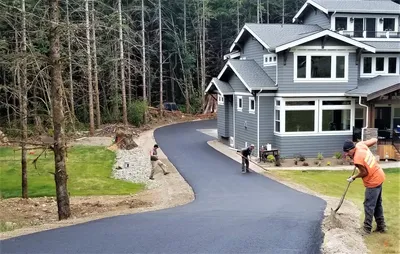Driveways
Goal
When it comes to driveways, our goal is to make it functional and aesthetically pleasing.
Design
During our on-site consultation I will listen to what you would like to have paved and I will make suggestions if needed to come up with a design that allows ample space and looks great. I n the end, you will choose what is best for you.
Estimate
I will then measure your driveway and get back to you, usually within 24 - 48 hours (sooner upon request), with an estimate so you will know the cost up front.
Time Frame
Once you sign and return the estimate we will call to schedule a date to pave your driveway - usually within 1 to 2 weeks, weather permitting.
Potholes and Sinkholes
Potholes are usually the result of the ground beneath the asphalt being unstable which allows the asphalt to flex up and down 100's to 1,000's of times when driven over by traffic.
Asphalt is made to flex somewhat, but when the back and forth motion of the weight of the car driving over it and then driving off of it, the pavement can flex beyond what the pavement is capable.
At first the asphalt will usually alligator (see asphalt cracking page). Eventually the broken pieces of asphalt start to lift above the other pavement and the tires kick the pavement out and the scattered loose pieces create a pothole.
Potholes can damage your car and are a nuisance to drive through. Most of the time we can just fill in the potholes if the surrounding edges are stable. Otherwise, we may need to cut the edges to deter cracking around the repaired pothole. Sometimes it is also recommended to over-excavate the area beneath the pothole and fill it with rock or extra asphalt to reduce flexing that may re-create a pothole in the same area.
Sinkholes Sinkholes or depressions in the pavement can be caused by many things, but not limited to the following major causes:
1.Soft grade / ground movement. (Usually a 1' to 4' round hole) This can be overlaid or removed and replaced.
2.Improperly compacted subgrade or utility lines. If this is the cause, we usually remove the sunken pavement and repave it. No other action is required unless the subgrade is soft.
3.Tree stump deterioration. Often times a stump or roots can deteriorate over a period of many years. If rotten stumps are the cause then we need to over-excavate and haul away the stump / dirt, fill with rock and repave it. Though more costly, it is the only proper and "safe" solution.
Cracks & Fissures
It is important to repair cracks in pavement to minimize water penetration which softens the ground and will freeze and thaw, causing more cracking or become potholes.
There are two main types of cracking that occur in asphalt.
Alligatored
Small to large areas of cracked pavement that resemble the back of an alligator. The sizes range from 2" to 2' chunks.
This kind of cracking is best repaired by removing the alligatored pavement and replacing it with new asphalt. sometimes it is recommended to over-excavate the area and add rock or extra asphalt if the ground below is soft. Alligatored pavement can also be overlaid - ONLY - if Petromat is placed first to deter future cracking.
Fissures
Hairline cracking is comprised of cracks that usually go in one direction and do not connect on all sides like the alligatored pavement.
This kind of cracking can often be filled with hot liquid asphalt or rubberized crack filler for cracks up to 1/2" wide and is cheaper to repair.
Testimonials
Asphalt By George is your trusted partner for all your asphalt needs throughout Snoqualmie, WA.
I recently had my driveway redone by Asphalt By George, and the experience was outstanding. From the initial consultation to the final touches, their team was professional, courteous, and incredibly skilled. The new driveway has completely transformed the look of my property. I highly recommend them for anyone in Snoqualmie looking for top-quality asphalt services."
As a business owner in Snoqualmie, I understand the importance of first impressions. That's why I chose Asphalt By George for our parking lot paving. Their attention to detail and commitment to quality were evident throughout the project. Our new parking lot looks fantastic and has received numerous compliments from our customers."
Our community needed a reliable company to handle various asphalt repairs. Asphalt By George was exceptional in their service. They were knowledgeable about the unique weather challenges in Snoqualmie and completed the job efficiently with minimal disruption. It's clear they prioritize customer satisfaction and quality work."




